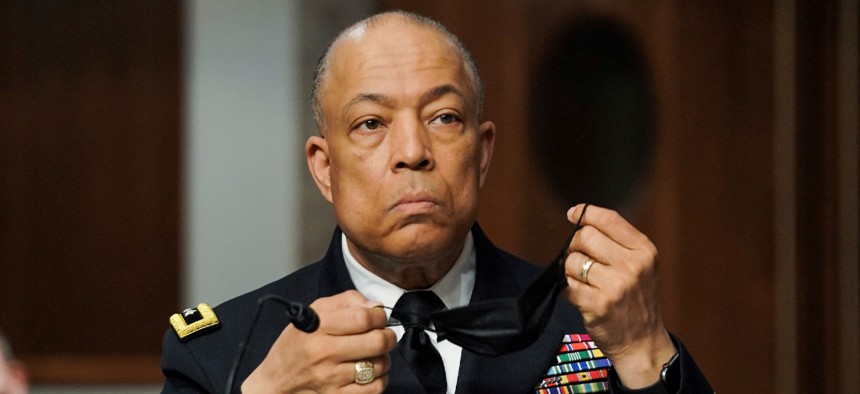
Army Maj. Gen. William Walker, commanding general of the District of Columbia National Guard, answers questions during a Senate Homeland Security and Governmental Affairs & Senate Rules and Administration joint hearing on Wednesday. Greg Nash/Pool via AP
D.C. Guard Commander Says ‘Unusual’ Restrictions Prevented Swift Response To Capitol Riot
“I believe that number could have made a difference,” he said.
“Unusual” restrictions placed on the commander of the D.C. National Guard prevented him from responding to the besieged Capitol on Jan. 6 more quickly, he told Senate lawmakers during a high-profile hearing on Wednesday.
A Jan. 5 letter from the secretary of the Army — under whose authority the D.C. National Guard operates — required Maj. Gen. William Walker to submit a “concept of operation” before deploying what is known as a quick reaction force.
“I found that requirement to be unusual, as was the requirement to seek approval to move Guardsmen supporting the Metropolitan Police Department to move from one traffic control point to another,” Walker said. “The memo was unusual in that it required me to seek authorization from the secretary of the Army and the secretary of defense to essentially even protect my Guardsmen.”
As rioters besieged the Capitol the following afternoon, Walker received an emotional plea for help from the Capitol Police Chief; he quickly sent the request to the Pentagon. More than three hours passed before he received permission to send his forces to defend the Capitol. Had he not been under those restrictions, he said, he could have immediately sent about 150 soldiers to the Capitol.
“I believe that number could have made a difference,” he said. “We could have helped extend the perimeter and helped push back the crowd.”
Walker placed much of the blame for the lengthy delay on senior Pentagon leaders, detailing a Jan. 6 phone call in which senior Army leaders expressed reluctance to deploy uniformed Guardsmen to the Capitol. Walker singled out two senior members of the Army staff by name: deputy chief of staff for operations Lt. Gen. Charles Flynn, the brother of former national security advisor Mike Flynn, and Lt. Gen. Walter Piatt, the director of the Army staff.
Neither had the authority to approve the request, Walker said, but both said “it wouldn't be their best military advice to send uniform Guardsmen to the Capitol because they didn't like the optics and they had also said that they thought it could inflame [the protesters].”
Walker said this left him “frustrated” and “stunned.”
“What they wanted to do was send Guardsmen to relieve police officers in the city so more policemen could get to the Capitol,” he said.
Army Secretary Ryan McCarthy, who did have the authority to approve Walker’s request, was not on the call.
Robert G. Salesses, the Pentagon’s acting assistant secretary for homeland defense and global security, pushed back on Walker’s characterization of the call. In Salesses’ own testimony on Wednesday, he emphasized that neither Piatt nor Flynn were “decisionmakers” — neither are in the chain of command for the D.C. Guard — and said Piatt had told him he never used the word “optics.”
Retorted Walker: “There were people in the room with me on that call that heard what they heard.”
The D.C. Guard chief testified that he was prepared to send troops as soon as he received the necessary authorization. He ordered the quick reaction force from Andrews Air Force Base to the Armory as soon as he got off of the phone with the Capitol Police chief and loaded them onto buses to wait, “in anticipation of a green light.”
“One of my lieutenant colonels, on his own initiative, went to the Capitol, anticipating that we were going to be called…and he met with Deputy Chief Carroll of the Metropolitan Police Department, who asked him, ‘Where is the National Guard? How come you're not here?’
“And this colonel said, ‘Well, I'm sure they're coming. And I'm here to scout out where they're going to be when they get here.’”
During the three hours and 19 minutes that Pentagon leaders were deliberating Walker’s request, Salesses said, McCarthy “was trying to understand, what was the National Guard going to do when they came up here? Were they going to be asked to go into the building and clear the building? Were they going to be part of the outside perimeter?”
Another reason for the delay, Salesses said, was the Pentagon’s reaction to the criticism the Guard took after it was deployed in response to the Black Lives Matter protests in Washington in June. During that deployment, helicopters hovered low over the heads of protesters in a clear show of force, and Guard members were present during the forcible clearing of Lafayette Square.
“That then led, in some way, to this reaction where, ‘Well, we're going to be careful. We're going to be more careful. We're going to put some restraints on how we deploy the Guard that we previously haven't before.’ Have I got that correct?” asked Sen. Josh Hawley, R-Mo., who was one of the lawmakers who on Jan. 6 voted against the certification of the election results and who helped drive the false narrative that former President Donald Trump won the election — the spark behind the siege of the Capitol.
“That's exactly what happened, Senator,” Salesses said.
When approval finally did come, at 4:32 p.m., according to Salesses, it wasn’t transmitted to Walker until after 5 p.m., thirty minutes later.
“I think that's an issue,” acknowledged Salesses.
Within 20 minutes, the first Guardsmen had arrived at the U.S. Capitol.







